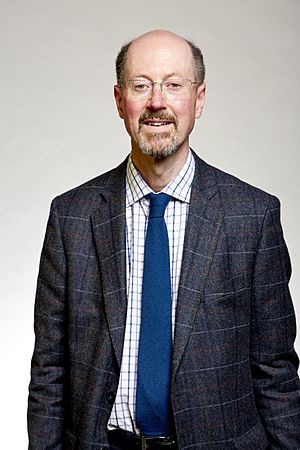Martin D. Dawson facts for kids
Quick facts for kids
Martin D. Dawson
FRS FRSE FInstP FIEEE
|
|
|---|---|
 |
|
| Born | 1960 |
| Nationality | British |
| Alma mater | Imperial College London |
| Known for | Photonics microLEDs VECSELs diamond photonics |
| Scientific career | |
| Fields | Photonics |
| Institutions | University of Strathclyde |
| Doctoral advisor | Prof Wilson Sibbett |
Martin D. Dawson is a British professor born in 1960. He is a leading expert in photonics, which is the science of light. He works at the University of Strathclyde in Scotland, where he helps lead the Institute of Photonics. He also heads the Fraunhofer Centre for Applied Photonics. Professor Dawson is known for his important work in making new light technologies.
What Professor Dawson Does
Professor Dawson is a physicist who studies light and how it can be used in new ways. He is famous for his work on lasers, tiny lights called microLEDs, and special materials called compound semiconductors.
He helped start the Institute of Photonics at the University of Strathclyde in 1996. This institute focuses on using light in practical ways. In 2012, he also became the first head of the Fraunhofer Centre for Applied Photonics. He has worked for over 30 years in research, both at universities and in companies. He has even helped create new companies that use his research.
Lasers: VECSELs
Professor Dawson is a pioneer in a special type of laser called a Vertical External-Cavity Surface-Emitting Laser, or VECSEL. Since 1997, he has been developing these lasers. He has achieved many "world firsts" with them. For example, he was the first to make these lasers produce a single, adjustable color of light.
Tiny Lights: MicroLEDs
Back in 1996, Professor Dawson realized how important tiny lights made from gallium nitride (GaN) would become. These are called micro-LEDs. Today, these tiny lights are very popular because they can be used to make amazing displays for phones, TVs, and virtual reality headsets.
His work on microLEDs has also shown how they can be used in other cool ways:
- As light sources for optogenetics, which uses light to control cells.
- For Li-Fi, a technology that uses light to send data, like Wi-Fi but with light. This is part of visible light communications.
Professor Dawson has written over 90 scientific papers just about microLEDs. His research even led to a company called mLED Ltd being created from the University of Strathclyde. This company was later sold to Oculus in 2016. He has been a leader in developing GaN micro-LEDs for Li-Fi since 2010. In 2014, he showed how micro-LEDs could send data at super-fast speeds, like several gigabits per second!
Professor Dawson's expert advice on new technologies has been sought by the UK Parliament.
Awards and Recognition
Professor Dawson has received many important awards for his work:
- In 2016, he won the Gabor Medal and Prize from the Institute of Physics. This was for his leadership in light science, especially for his work on semiconductor lasers, diamond photonics, and gallium nitride optical systems. The award also recognized his efforts to help these technologies grow and be used around the world.
- Also in 2016, he received the Aron Kessel Award from the IEEE Photonics Society. This award was for his wide-ranging and ongoing contributions to semiconductor opto-electronic engineering, including his work on lasers and microdevices.
- In 2021, he was given the Nick Holonyak Award by the Optical Society. He was the first person from the UK to receive this award. It recognized his many contributions to developing and using III-V semiconductor devices, especially gallium nitride micro-LEDs and optically-pumped semiconductor lasers.
- In 2021, he also received the Global SSL Award of Outstanding Achievements from the International SSL Alliance. This award was for his pioneering work in micro-LED technology. The award noted that he is "arguably the most imaginative and extensive contributor worldwide to this research field."
Professor Dawson is also a member of several important scientific groups:
- Fellow of the Institute of Physics (2000)
- Fellow of the OSA (2006)
- Fellow of the Royal Society of Edinburgh (2007)
- Fellow of IEEE (2009)
- Fellow of the Royal Society (2022)

